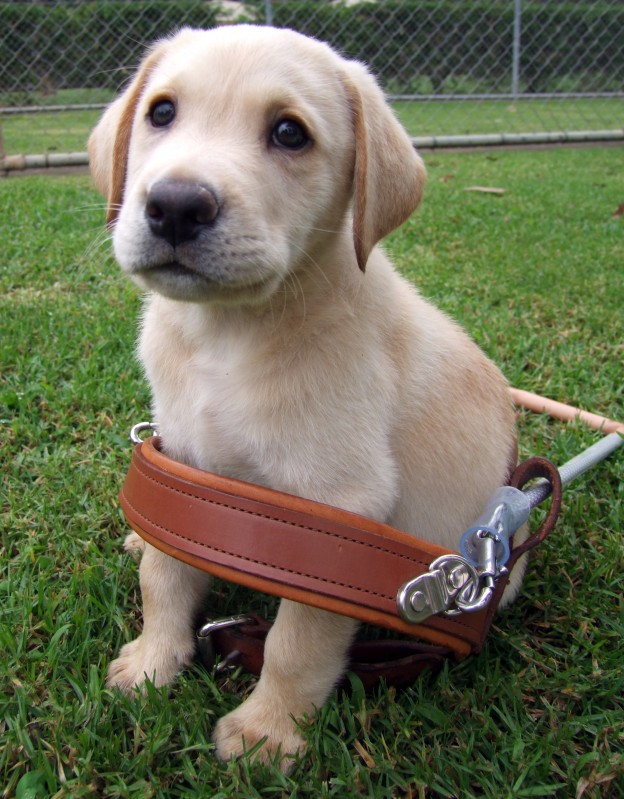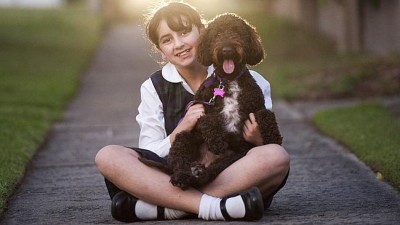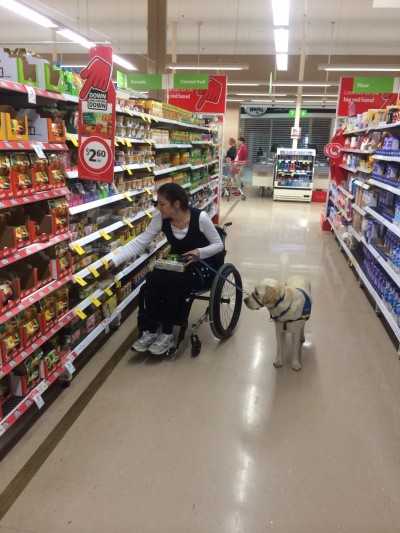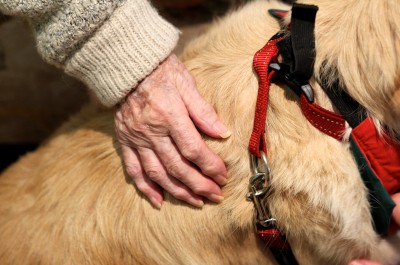
Have you ever thought how assistance dogs go from playful pups to sensible and loyal companions? Kylie Baracz speaks to the organisations that train dogs to help us in times of need.
Charles Ulm, Guide Dogs Australia
What is a Guide Dog?
A Guide Dog is a working dog that has been highly trained to guide someone with impaired vision safely from one location to another.
Why are Guide Dogs important?
Guide Dogs enable people with vision impairment to get around independently and safely, and to participate fully in their communities.
How many people have Guide Dogs in Australia?
There are more than 800 working Guide Dogs in Australia.
How much does it cost to train a Guide Dog?
The process of turning a playful puppy into a responsible, working Guide Dog is quite incredible, taking almost two years and costing more than $30,000– equivalent to the cost of a car. Guide Dogs are provided free of charge to people with impaired vision.
How is a Guide Dog trained?
From eight weeks to 14 months, these special puppies live with volunteer puppy raisers, whose responsibility it is to provide a loving home as well as basic obedience.
At 14 months, pups return to the Guide Dog Centre where they are assessed on health and temperament. Puppies that are selected to become Guide Dogs then undergo five months of intensive training, learning the skills they will need to safely guide a vision impaired handler.
Training includes: how to ignore distractions such as food and noises; navigate obstacles; travel on public transport; and find landmarks such as bus stops and cross roads safely.
Some tasks, like stopping at all curbs and staircases, are taught through repetition. Other tasks require intensive training, like negotiating a busy train platform to find the train doors. As training progresses, Guide Dogs learn to travel through confusing and crowded areas, such as shopping centres and busy city streets.
What breeds of dogs make good Guide Dogs?
Aspiring puppies are carefully selected according to their confidence, responsiveness and health. In Australia, Guide Dogs are usually purebred Labradors and Golden Retrievers, because they’re calm, loyal and intelligent breeds with a proven track record as Guide Dogs.
Do all the puppies in the program become Guide Dogs?
For various reasons, from health to temperament, not all dogs are suitable to becoming Guide Dogs — some are better suited to companion work, while others make great family pets. The criteria for selection are extremely stringent as the personal safety of future handlers is paramount.
What happens to a Guide Dog when it retires?
Guide Dogs usually retire after about eight to 10 years of service. The handler decides what they will do with their retired Guide Dog. They might keep it as their pet or offer it to be re-homed with a caring family in the community.
Guide Dog facts and fibs
Dr Graeme White, CEO of Guide Dogs NSW/ACT, says key facts about Guide Dogs that the public generally misunderstand are:
- that patting a Guide Dog distracts it from its job, putting its handler’s safety at risk;
- that Guide Dogs are legally allowed into all buildings and on transport;
- that a Guide Dog doesn’t make decisions about where to go or when to cross the street as it relies on instructions from its handler.
“A Guide Dog is a bit like a car. We use a car to get around independently but the car doesn’t make decisions on where to go. A Guide Dog enables a person who is blind or vision impaired to be independently mobile but it’s one better than a car because it stops and alerts its handler to any danger or obstructions in their path,” says Dr White.
“With increasing numbers of Guide Dogs working on our streets as a result of rising vision loss, we believe it’s critical that the public fully understands the important role of Guide Dogs in the community,” he adds.
Sue Cale, Taloodles Therapy and Assistance Labradoodles

What is the role of a therapy dog?
There are lots of applications for therapy dogs in the community. One of their greatest strengths is that they offer unconditional, non-judgemental affection — they don’t care if people are different, what race they are or what their intellectual or physical capacity is. Generally therapy dogs are allocated to individuals; however, we do have a young dog, Taloodles Archie, who has recently started spending a couple of hours a week at a school in the local area. Archie is being used in a variety of ways — in the counsellor’s office to engage the children in conversation; the children take turns in reading to him – he has a calming influence on the kids and he doesn’t care whether their reading is good or bad, generally the children stroke him while they read; he has been used in role-playing in the classroom; he is used in situations where children who find it hard to focus are asked to perform a task and their reward is to sit with Archie for a few minutes if they successfully complete their task.
Why are they so important?
Therapy dogs can be trained to assist their recipients to perform a range of tasks, however, some of their greatest strengths include:
- lowering anxiety and stress levels;
- boosting happiness;
- improving social skills and communication;
- the development of empathy;
- assisting to overcome speech and emotional disorders;
- improving motivation to learn;
- building self esteem;
- providing nurturing, accepting and unconditional love;
- reducing loneliness.
Can any dog become a therapy dog? If not, what does it take?
No, not every dog is suited to being a therapy dog. The most important character trait in the selection of a therapy dog is temperament. The dogs need to have calm and accepting temperaments. All the dogs selected for Taloodles are selected not for size, colour, agility or mental acuity but purely for temperament. You can train a dog to do lots of things but you cannot train temperament into a dog, they are born with it.
What is involved when training therapy dogs?
We start working with the puppies at about eight weeks of age. We employ professional trainers who work with us and the puppies twice a week. We then continue that training on a daily basis.
Training sessions involve obedience training, exposure to lots of different situations, i.e. train stations; car parks; walking through shopping centres with crowds of people; busy roads; preschools; schools; confidence building exercises; and regular assessments, to ensure that the dogs are meeting training milestones. We ensure that all these experiences are positive ones for the puppies which encourage them to embrace and accept change.
We train our dogs to the Canine Good Citizen standard — the pups are assessed and tested at six months of age to the Canine Good Citizen Bronze standard and then work towards attaining Canine Good Citizen Silver accreditation prior to placement. This testing involves working in and around people and other dogs and ensuring that the dogs are stable and well-mannered at all times.
What costs are involved in raising and training a therapy dog?
There are many costs involved in raising and training therapy dogs — veterinary, grooming, food, toys, equipment, treats, insurance and professional training costs. It costs approximately $7,500 to train a therapy puppy; this does not include the hours of training that go into the dogs outside their formal training.
Therapy dogs placed
Taloodles Daisy
Daisy was the very first Taloodle and was placed with her recipient just over 12 months ago. Daisy is a very sweet natured, little dog who was placed with Bianca. Bianca is 11 years old and has high functioning autism, receptive and expressive language disorders in the severe range, cognitive and intellectual delay and Attention Deficit Hyperactivity Disorder — all of these disorders make every day for her family challenging as all these disorders can present simultaneously.
Bianca has also suffered with anxiety and depression and has been bullied at school by her peers. Bianca has an over sensitivity to loud places like concerts and swimming carnivals and has a tactile sensitivity to hair washing and clothing. Daisy has provided Bianca with a constant, non judgemental, loving friend. Daisy gives Bianca great emotional support and reduces her anxiety and depression.
Bianca’s self esteem and self confidence have improved significantly as have her social skills and ability to engage with adults and other children. She regularly reads to Daisy which has assisted with improving her reading and language skills. Bianca has also learnt responsibility, patience and caring through her interaction with Daisy. The relationship between Daisy and Bianca is a very special one — Daisy is Bianca’s best friend.
Taloodles Poppy
Poppy’s placement is probably one of the most special placements we will ever make. Poppy was placed with brothers Jack and Ben in August 2014. Jack aged 14 and Ben aged 12, both have undiagnosed genetic conditions, they are in wheelchairs and are non verbal.
Poppy has had a significant impact on their lives in the short time that she has been with them. If the boys come home stressed or upset from school, she comforts them and her funny antics never fail to make them smile. She is happy to lie quietly with them whilst they watch television and her calming presence assists them go to sleep at night.
Patting her and giving her treats is assisting their gross motor skills and her constant companionship also alleviates their feelings of anxiety. This is a very special placement because the whole family are benefiting from Poppy’s addition to their lives.
Amanda Hope, Assistance Dogs Australia

What is the role of an assistance dog?
Assistance Dogs help people with disabilities and give them freedom and independence. They assist their clients with things such as picking up dropped items, opening and closing doors, pressing the button at the traffic lights and alert barking when their client is in trouble.
Why are they so important?
Assistance Dogs give their clients the confidence to get out and about, and improve their self esteem. Assistance Dogs also provide emotional support as well as a physical service to their ‘team mate’. They bring independence, freedom, confidence, happiness and hope.
Can any dog become an assistance dog? If not, what does it take?
We raise and train Labradors and Golden Retrievers to be Assistance Dogs. These dogs enjoy learning new things and love being around people.
What is involved when training assistance dogs?
Each dog takes two years to train. To train an Assistance Dog over a two year period costs $27,000, and this covers things such as vet visits, food, bedding, toys, travel costs etc.
At eight weeks of age, the puppies arrive at the training centre and commence the first four to eight weeks of their training with puppy socialisers. After this, they go to their puppy educators. Each pup and puppy educator has a two-hour orientation with one of Assistance Dogs Australia’s Instructors before they go home with the puppy educator. This orientation covers the training structure, crate and house training and health care. The puppy educators will care for the pups in their home for the next 12-14 months, providing them with basic obedience training and socialization. For the first six months, pups and educators attend kindergarten training classes once a week with an Assistance Dogs Australia Instructor and then once every two months for the remainder of the time. We encourage puppy educators to take the pups everywhere so that the pups are socialised in a range of community settings. They can go to shopping centres, the supermarket, on public transport, to the cinema, everywhere! If puppy educators go on holidays etc we also have puppy carers to look after the dogs while they are away.
After spending 12-14 months with their puppy educators, the dogs will board at Assistance Dogs Australia’s training centre for six to nine months of intensive training. Intensive training takes place at our national training centre in Sydney. Our professional instructors teach the dogs more than 40 commands to prepare them for placement. Each dog receives four training sessions a day and many of these sessions are carried out in public places and on public transport. By the time the dogs have completed their training they have been thoroughly socialised and tested in the local community. We currently have a Bed-and-Breakfast program running too which ensures dogs can have some rest and relaxation for a few days at a time, in the home of a volunteer during this intensive training period.
Natasha and Biscuit
Assistance Dog Biscuit is the best Christmas present Natasha from Launceston could have wished for. Natasha was born with Cerebral Palsy and uses a wheelchair each day to get around, and now she has Biscuit by her side to keep her company. Biscuit accompanies Natasha to work each day and is happy to settle under her desk and wait patiently until his help is needed.
“Biscuit takes the focus off my disability and gives me a feeling of security; he’s always watching out for me and gives me a reason for getting up each day. He can pick up my crutches off the floor, and when I’m at work he loves to collect the mail and give it to the receptionist. Because I have Biscuit I go out every day now, I have him to thank for that!”
Natasha often needs to travel for work, taking Biscuit along with her, he even recently attended her work Christmas party and also loves his weekend visits to the beach and drives in the car. Having had a dog before Natasha researched online and discovered Assistance Dogs Australia, and decided a furry four legged friend would be able to lend her a paw as well as provide her companionship.
Biscuit gets along well with Natasha’s mum who is always happy to give him an extra treat or two, and has another four legged friend at home for company, a Jack Russell called Lucy who belongs to Natasha’s partner. He has worked out how to help himself to the toys in the toy box, but loves to snooze in his bed in the lounge room at the end of the day.
Liz Woodward, Delta Therapy Dogs

What is the role of a therapy dog in the community?
Therapy dogs bring joy to the lives of twelve million Australians and now there is evidence they are also literally good for your health and wellbeing! Through our world class Delta Therapy Dogs program, the Delta Society aims to bring these benefits to the sick and infirm — children and adults who are in hospitals and nursing homes around Australia. Delta Therapy dog teams have encouraged residents to leave the confines of their rooms for the first time in months, to extend their hand post-stroke or surgery, to walk, to talk, to smile, to laugh, to remember, to forget, and to reminisce about their own animals
Why are they so important?
Delta Therapy Dogs benefit many people in the community such as the elderly, hospital patients and children; and provide support for occupational therapy. (See box out for details)
Can any dog become a therapy dog? If not, what does it take?
No, to become a Delta Therapy Dog, dogs must be at least 18 months old and under 10 years old with basic manners. Dogs are required to be fully vaccinated (C5), be on heartworm preventative medication and treated regularly for internal and external parasites. They are also required to have a vet health screening test to determine their suitability to visit physically, and lastly, the dogs must pass a strict temperament assessment.
We don’t train the dogs ourselves — the dogs belong to a volunteer and they come to us to be assessed — and they can only work in facilities that join up with Delta and pay the annual donation for the dog to visit.
Benefits of Delta Therapy Dogs
For the elderly
In nursing homes studies show that the benefits of AAT include:
- patient-therapist interaction
- staff–animal interaction
- increased muscle strength and range of motion
- pain management
- reduction of blood pressure and heart rate
- greater self–esteem and emotional well-being
- improved patient independence
- improved social interactions
- creating a home-like environment
- and… a positive effect on the community
For hospital patients
Hospital patients benefit both physiologically and psychologically from pet visits. These benefits include:
- reductions in blood pressure and heart rate
- reduced anxiety
- decreases in stress levels
- decreased depression
- distraction from pain
- decreased stress
- improvements in physical functions due to petting animals
- increased feelings of self-worth
- helps with mood disorders such as schizophrenia
In occupational therapy (adults and children) AAT helps with:
- increased motivation for therapy
- increased range of motion
- better sensory interpretation
- higher tolerance for physical activity when pain is present
In people with chronic mental illness AAT results in:
- increased alertness
- increased cognitive ability
- increased communication (verbal or non-verbal)
- increase social interaction with other people
- building of confidence and self esteem
For children
In children in general, animals facilitate development of:
- relationships and friendships
- non-verbal communication
- sense of responsibility (care & ecological responsibility)
- learning about life cycles and ecology
- psychological & physiological health
- stimulates emotions
In residential facilities, AAT increases attention span, physical movement, communication, compliance and social interaction and reduces stress.
In hospitals, studies have shown that AAT helps children with mood disorders. Australian studies have shown that AAA dog visitation programs in hospitals help:
- distract children from their illness
- relax children
- make the ward a happier place, establishing a homely environment
- stimulate communication
In schools, AAA and AAT can help children become:
- less aggressive
- less hyperactive and more focused (Children pay attention to dog but also more to teacher)
- more socially integrated
- more playful
- better readers (reading to a dog increases reading level) – also reduces stress levels
- less truant
A recent Delta study shown that children benefit from:
- positive effect on reading
- academic improvements
- increased social emotional wellbeing
- positive effect on children with autism
- increased engagement in reading
- improved community link
AAT can also assist children with pervasive development disorders such as autism. The results include:
- greater use of language
- greater social interaction
- encourage awareness of surroundings
Make training easier with help from the professionals - on our DOGSLife Directory now!




